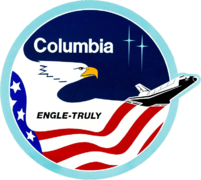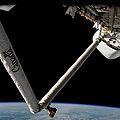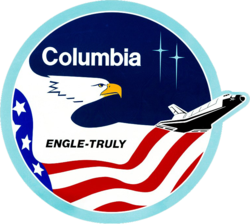STS-2
| Missionsemblem | |||||
|---|---|---|---|---|---|
 | |||||
| Missionsstatistik | |||||
| Missionsnavn: | STS-2 | ||||
| Rumagentur: | NASA | ||||
| Rumfærge: | Columbia (2) | ||||
| Antal besætningsmedlemmer: | 2 | ||||
| Affyringsrampe: | LC-39A (KSC) | ||||
| Opsendelse: | 12 november 1981, 15:06:59 UTC | ||||
| Landing: | 14 november 1981, 21:23:11 UTC | ||||
| Landet på: | Edwards Air Force Base (Runway 23) | ||||
| Varighed: | 2 dage, 6:13:12 | ||||
| Antal kredsløb: | 36 | ||||
| Apogæum: | 231 km | ||||
| Perigæum: | 222 km | ||||
| Kredsløbets højde: | 307 km | ||||
| Kredsløbets inklination: | 38.0° | ||||
| Kredsløbstid: | 89.0 minutter | ||||
| Tilbagelagt afstand: | 1.729.654 km | ||||
| Masse: | 104647 kg | ||||
| Foto af besætningen | |||||
 (V-H) Besætningsmedlemmer Joseph H. Engle og Richard H. Truly | |||||
| Navigation | |||||
| |||||
STS-2 (Space Transportation System-2) var NASAs anden rumfærge-mission. Opsendt 12. november 1981 og vendte tilbage den 14. november 1981.
Det var første gang, et bemandet genbrugeligt rumfartøj fløj ud i rummet for 2. gang.
Missionen der skulle have varet i fem blev afkortet til to dage pga. problemer i de systemer der skulle producere elektricitet og drikkevand, systemet blev derfor senere udskiftet.[1]
Forsøg med den ny robot-arm på rumfærgen blev derfor udskudt til en senere mission.
Under missionen fik NASA besøg af den daværende præsident Ronald Reagan.
Missionen
STS-2 var ligesom STS-1 en test-mission. Målet var derfor sikker opsendelse og returnering af rumfærge og besætning. Rumfærgens faststofraketter landede i faldskærm på havet til genbrug, mens den udvendige tank brændte op i atmosfæren som planlagt.
Besætningen og rumfærgen kom tilbage uden alvorlige skader. 90% af de planlagte eksperimenter blev udført. Dette skyldes at astronauterne ikke ville spilde tiden og forsatte med at arbejde også om natten, da missionen blev afkortet tre dage.
Afprøvning af eksperimenter på rumfærgen:
- Orbital Flight Test .
- Air Pollution from Satellite (MAPS).
- Shuttle Multispectral Infrared Radiometer (SMIRR).
- Imaging Radar (SIR-A).
- Features Identification and Location (FILE).
- Ocean Color (OCE).
- Development Flight Instrumentation (DFI)
- Aerodynamic Coefficient Identification Package (ACIP)
- Environment Contamination Monitor (IECM)
- Office of Space and Terrestrial Applications (OSTA-1).
Rumfærgens varmeskjold fik mindre skader, ingen kakler var faldet af, men 12 var beskadiget.
Besætning
De to testpiloter sad i katapultsæder.

 Joseph H. Engle (Kaptajn, X-15-veteran)
Joseph H. Engle (Kaptajn, X-15-veteran)
 Richard H. Truly (Pilot, Enterprise-veteran)
Richard H. Truly (Pilot, Enterprise-veteran)
Vægt
- Kredsløbsfartøj (ved opsendelse): 104647 kg.
- Kredsløbsfartøj (ved landing): 92650 kg.
- Last: 8517 kg.
- STS-2 opsendelsen set fra luften.
- Besætningen på STS-2.
- Robot-armen kaldtes Canadarm, den var produceret i Canada.
- Columbia før landing.
Eksterne henvisninger
- STS-2 NASA (engelsk)
- STS-2 Video, Astronauterne Joe Engle og Richard Truly kommenterer Arkiveret 29. januar 2010 hos Wayback Machine National Space Society (NNS) (engelsk)
- ^ Fuel Cell Power Plants Arkiveret 10. februar 2008 hos Wayback Machine (engelsk)
| ||||||||
Medier brugt på denne side
S81-36714 (14 Nov. 1981) --- STS-2 backup Crewmen Jack Lousma and Gordon Fullerton in the bldg 5 Shuttle mission simulator. These two veteran astronauts were named today as the official prime crew members of STS-3 in the space shuttle Columbia. Commander for NASA's third space shuttle orbital flight test is astronaut Jack R. Lousma, left, seated in a Shuttle Mission Simulator (SMS) at NASA's Johnson Space Center (JSC). Astronaut C. Gordon Fullerton, right, will serve as pilot. Lousma was pilot on the second of three NASA crews to visit the Earth orbiting Skylab space station in 1973. Fullerton, though never having been in space, is a veteran of three free flights of the shuttle during approach and landing tests (ALT) with space shuttle Enterprise in 1977.
Official portrait of STS-2 crewmembers Joe H. Engle (commander), left, and Richard H. Truly (pilot) posing in ejection escape suits (EES) with a model of the space shuttle.
Mission patch for STS-2 Space Shuttle mission
The underside of Columbia as it makes its final approach before landing on the Rogers Dry Lakebed at Edwards Air Force Base, California. The Shuttle was piloted by Richard Truly who would go on to become NASA's eighth Administrator.
This scene represents the end of NASA's STS-1 mission and the beginning of STS-2 in that the orbiter Columbia is arriving at Kennedy Space Center in Florida to begin the lengthy process of preparing it for STS-2. The vehicle landed at Dryden Flight Research Center on April 14 after an historic 2 1/3 day flight in Earth orbit. It was mated to this 747 aircraft, titled NASA 905, and flown over the USA to its Florida destination. It was later removed from atop NASA 905 and moved to the orbiter processing facility for the beginning of refurbishment.
STS002-13-226 -- On Space Shuttle mission STS-2, Nov. 1981, the Canadarm is flown in space for the first time.
Forfatter/Opretter: Kwamikagami, Licens: CC BY-SA 4.0
symbol of Mars. 16 × 16 pixel nominal dimensions, lines 2 pixel thick, square caps. Colour 75% blue: red=0 green=0 blue=191 (#0000BF).
Aerial view of the STS-2 Columbia launch from Pad 39A at the Kennedy Space Center, Florida, taken by astronaut John Young aboard NASA's Shuttle Training Aircraft (STA).













